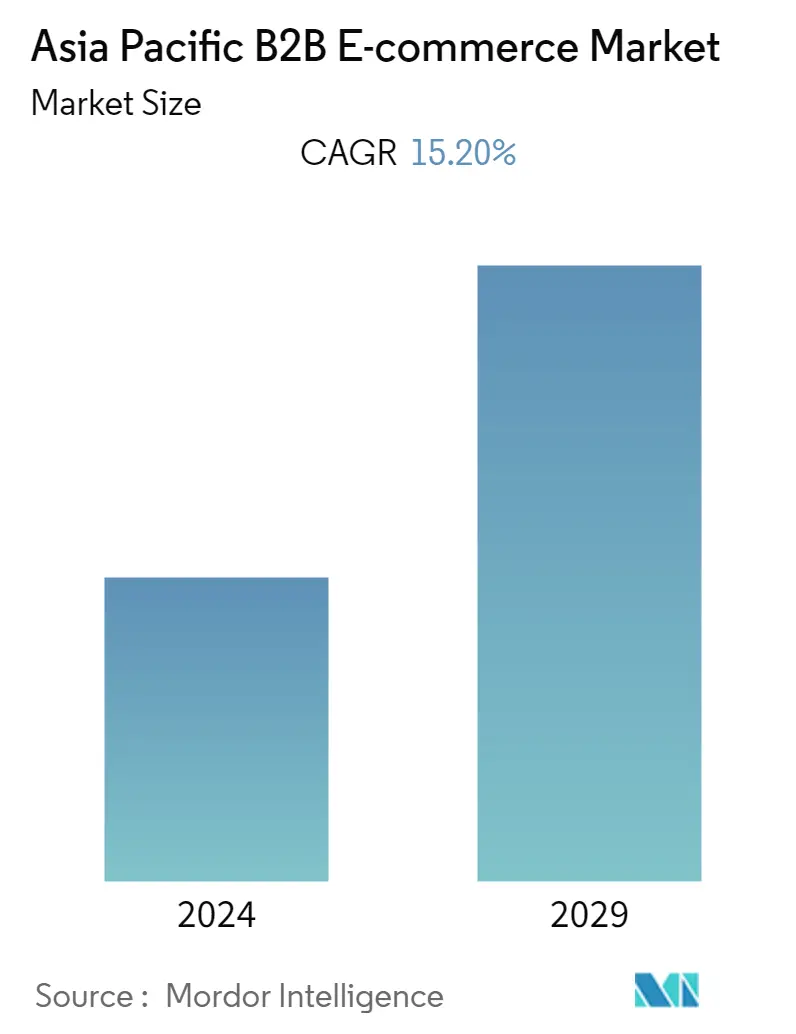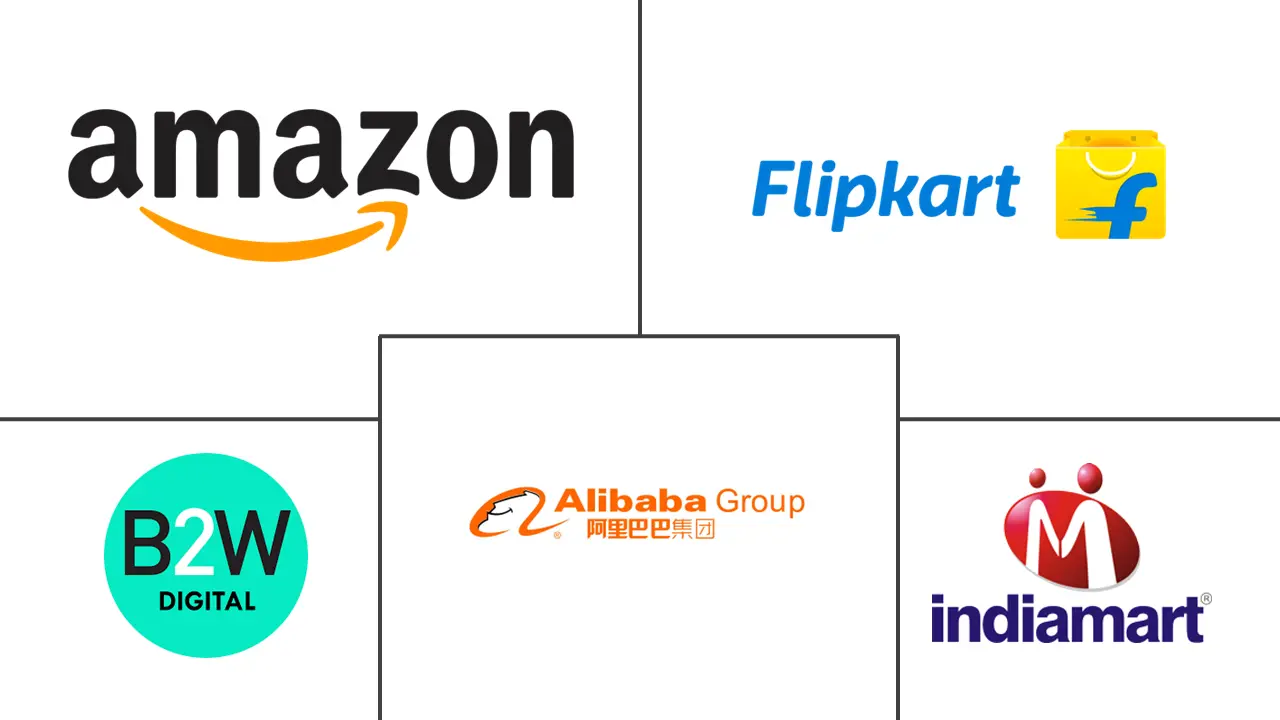Market Size of Asia Pacific B2B E-commerce Industry

| Study Period | 2019 - 2029 |
| Base Year For Estimation | 2023 |
| Forecast Data Period | 2024 - 2029 |
| Historical Data Period | 2019 - 2022 |
| CAGR | 15.20 % |
| Market Concentration | Medium |
Major Players
*Disclaimer: Major Players sorted in no particular order |
APAC B2B Ecommerce Market Analysis
The Asia Pacific B2B E-commerce Market is anticipated to grow with a CAGR of 15.2 % during the forecast period (2022 - 2027). B2B E-commerce enables businesses to customize each customer's checkout, document management, and agreement processes. This improves the B2B client experience while lowering human error rates that may otherwise result in lost business.
- According to Indian Brand Equity Foundation(IBEF), E-commerce has changed the way people do business in India. The Indian e-commerce sector is predicted to increase from USD 46.2 billion in 2020 to USD 188 billion by 2025. It is estimated to reach USD 350 billion by 2030. The Indian e-commerce market is expected to grow by 21.5% by 2022, reaching USD 74.8 billion. Such huge increase in the revenue is expected to created an opportunity for the B2B E-commerce to grow.
- Where immersive experiences matter in B2B E-commerce marketing, VR (virtual reality experiences) and AR (augmented reality) may reclaim some of their former prominence. Some B2B vendors may need to enable virtual testing and confirmation of complicated products, including replacement parts or custom designs, for customers.
- IoT and AI technical advancements are still impacting B2B E-commerce. From suppliers, managers, marketers, sales representatives, and customers, everyone participating in the process can gain from a more accurate prediction of their desired outcomes and advice on the best course of action. Mobile-only contributes to little more than half of the purchases.
- The shift from physical to virtual shopping accelerated during the pandemic, compelling most businesses to switch from on-premise operations to the cloud. COVID-19 has broadened the consumer base using e-commerce beyond millennials and digital natives to include older age groups. Many will continue to use this sales channel even when lockdown (shelter-in-place) orders are withdrawn, fundamentally reshaping the retail landscape.
- In E-commerce, electronic payment systems play a critical role. Electronic payment systems, often known as paperless monetary transactions, are used by e-commerce businesses. Decreasing paperwork, transaction expenses, and labor costs changed commercial processing. E-commerce processing is easier to use and takes less time than manual processing. Electronic commerce allows a company to broaden its market reach. The electronic payment mechanism carries a particular risk.
APAC B2B Ecommerce Industry Segmentation
Business-to-business or B2B e-Commerce platforms allow buyers and suppliers to interact and arrange the deliverables leveraging the services offered by the platform. The scope of the report includes sales made through B2B e-commerce sites and e-procurement channels. However, EDI sales are not included as part of the scope.
The Asia Pacific B2B E-commerce market is segmented by Channel (Direct sales and Marketplace sales) and Country.
| By Channel | |
| Direct Sales | |
| Marketplace Sales |
| By Geography (includes Market size (GMV) for the period of 2017-2027) | |
| China | |
| Japan | |
| India | |
| South Korea | |
| Rest of APAC |
Asia Pacific B2B E-commerce Market Size Summary
The Asia-Pacific B2B E-commerce market is experiencing significant growth, driven by advancements in technology and changing consumer behaviors. The shift from physical to virtual shopping, accelerated by the pandemic, has led to a broader consumer base embracing e-commerce, including older age groups. This transition has been supported by the integration of IoT, AI, and cloud-based technologies, which enhance the shopping experience through improved order fulfillment, predictive analytics, and personalized customer interactions. The market is also witnessing the rise of electronic payment systems, which streamline transactions and expand market reach. As businesses increasingly adopt digital transformation strategies, the importance of data analytics, network optimization, and cloud computing is becoming paramount, enabling companies to make informed marketing decisions and improve operational efficiency.
In the Asia-Pacific region, countries like China and India are at the forefront of this e-commerce boom, with vast internet user bases providing a substantial opportunity for market expansion. The region's B2B e-commerce landscape is moderately consolidated, with major players like Alibaba, Amazon, and Flipkart leading the charge. These companies are investing in strategic partnerships and technological advancements to enhance their market presence. Recent developments include the launch of platforms like Joybuy by JD Worldwide, which connects international retailers with Chinese manufacturers, and Peer Connexions by Tech Data India, which facilitates digital commerce for resellers. As the market continues to evolve, the focus on creating seamless, mobile-friendly payment solutions and enhancing online customer experiences remains a key priority for businesses aiming to capture a larger share of the growing B2B e-commerce market.
Asia Pacific B2B E-commerce Market Size - Table of Contents
-
1. MARKET INSIGHTS
-
1.1 Market Overview
-
1.2 Market size (GMV) for the period of 2017-2027
-
1.3 Industry Attractiveness - Porter's Five Forces Analysis
-
1.3.1 Bargaining Power of Suppliers
-
1.3.2 Bargaining Power of Buyers
-
1.3.3 Threat of New Entrants
-
1.3.4 Intensity of Competitive Rivalry
-
1.3.5 Threat of Substitutes
-
-
1.4 Assesment of COVID-19 on the Market
-
-
2. MARKET SEGMENTATION
-
2.1 By Channel
-
2.1.1 Direct Sales
-
2.1.2 Marketplace Sales
-
-
2.2 By Geography (includes Market size (GMV) for the period of 2017-2027)
-
2.2.1 China
-
2.2.2 Japan
-
2.2.3 India
-
2.2.4 South Korea
-
2.2.5 Rest of APAC
-
-
Asia Pacific B2B E-commerce Market Size FAQs
What is the current Asia Pacific B2B E-commerce Market size?
The Asia Pacific B2B E-commerce Market is projected to register a CAGR of 15.20% during the forecast period (2024-2029)
Who are the key players in Asia Pacific B2B E-commerce Market?
Alibaba Group Holding Ltd, Amazon.com, Inc., Flipkart Online Services Pvt. Ltd., B2W Companhia Digital and IndiaMart InterMesh Ltd are the major companies operating in the Asia Pacific B2B E-commerce Market.

